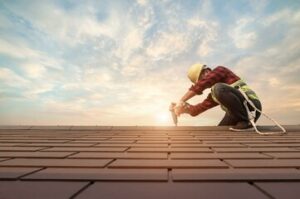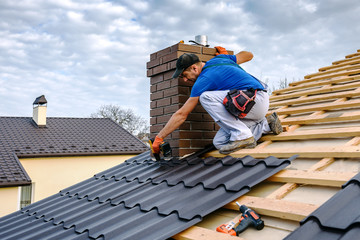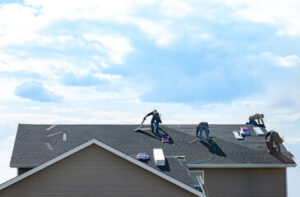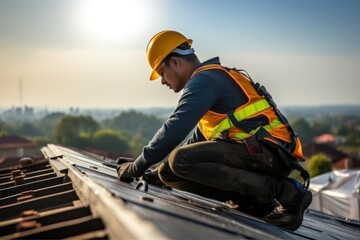When a home inspector climbs down off the roof and tells you that it needs to be replaced, your world can change in a flash.

It’s important to understand the process of roof replacement so you can ask the right questions. To learn more, visit https://www.portcharlotteroofers.com/.
A good roof is essential to the overall integrity of your home. It protects your family from harsh weather conditions like high winds and heavy rain. If yours has become worn out, it’s time to have a replacement installed. Whether it’s due to damage or simply to give your home a new look, replacing the old shingles with a more modern material is a wise investment.
Before the roofing team arrives, you need to do some prep work. First, clear the area around your house. Roofing professionals will need to walk all the way around your roof to get access from different angles, so they need a clear path without tripping on toys or patio furniture. It’s also a good idea to move any items that could be damaged by falling debris.
Remove valuable wall decorations, too. Hammering and drilling on the roof will cause vibrations that can shake the walls inside your home, especially those on the upper floors. This can damage mirrors, framed photos, and other decorations that hang from the walls.
Next, trim any overhanging trees. They can damage your shingles and can drop twigs or branches onto the roofing work area. This will reduce the risk of damage during the installation process.
If you have young children or pets, make arrangements to find alternate housing for them during the roof replacement. The noise and commotion associated with the process can disturb or frighten them, so it’s better to have them away from home while the work is done.
It’s a good idea to let your neighbors know about the roof replacement in advance, too. This will give them a heads-up so they can prepare for the extra traffic and debris in their yards. They might even be able to help with the cleanup!
Once the roofers arrive, they’ll begin by setting up protective barriers and beginning the tear-off process. They’ll then start installing the new shingles and other roofing materials. Afterward, they’ll clean up the property and inspect their work to ensure it meets your expectations. Then they’ll blow out the gutters and drains to clean them of any debris.
Installation
Before the actual installation of your roof begins, the roofing contractor will check with you to be sure that you are happy with the style and materials chosen for your new roof. At this point, you may want to consider switching from asphalt shingles to something more durable and environmentally friendly such as slate, tile or wood shakes. These can be more expensive than traditional shingles, but they are expected to last significantly longer and give your home a distinctive look that will increase its value.
The first step of a roof replacement is to remove the old one. The roofing crew will make sure that all cars are moved off of your driveway and will cover any plants or vehicles to prevent damage. After that, they will begin tearing off your existing roof in sections. They will start at the furthest corner of your roof away from your driveway and work their way towards it. This will save time and help them move quickly to the trailer for the new materials.
Once all the shingle debris is removed, a layer of self-stick underlayment will be attached to your roof deck and a sheet of felt or tar paper will be stapled over it for additional moisture protection. Your roof will also be inspected for cracks or rot in the sheathing. If your roof has any leaking areas, the roofing crew will replace the damaged pieces and seal them to keep water from seeping into your home.
The roofing contractor will also examine your gutters and downspouts to remove any debris or clogs that need attention. The crew will also remove any moss that is growing on your roof. This isn’t just unsightly; it locks in moisture that can cause serious roof damage.
If you aren’t sure if you can afford to pay for your new roof right now, there are financing options available. You can use a home equity loan or personal loan to cover the cost of a new roof. You should be aware that these loans typically come with higher interest rates than a mortgage would, but they are usually more flexible and can be funded faster than an equity loan.
Maintenance
The roof is a vital part of your home. It protects you from harsh weather and other elements, making it important to maintain its structure and prevent damage. It only takes a small amount of damage to create costly and time-consuming problems. Regular maintenance and tune-up services can help you maximize the lifespan of your roof. These tasks typically include inspecting and repairing surface materials, cleaning gutters and downspouts, checking for signs of water intrusion (such as mildew or mold), sealing leaky seams, and examining the exterior structural components to ensure that they are secure.
The choice of whether to repair or replace your roof depends on aesthetic versus structural damage, location and timing of the damage, age of the roof, owner-occupancy outlook, and costs. Facilities professionals should also consider the extent of moisture damage, as a roof replacement is necessary if there are significant leaks or other structural issues that cannot be resolved with repairs.
If you are replacing your roof, it may be a good opportunity to consider upgrading the material. Although more expensive, materials like slate, tile, wood shakes and metal offer a longer life span than asphalt shingles and add a more distinctive look to your property. Depending on your budget, you may also wish to upgrade other features of your roof, such as the fascia board, which can be damaged by water, animal damage, mold growth and rot and needs to be cleaned regularly.
A new roof can increase your property value, and you can choose from a wide range of colors and styles to match your style and needs. If you plan to live in your house for a long time, then a new roof can pay for itself through increased home value and energy savings. If you are not planning to remain in your house for a long period, then it may be worth taking out a loan to finance the cost of a roof replacement.
If you are having your roof replaced, it is a good idea to remove or put into temporary housing any pets that might be upset by the noise and strangers at your home. Hammering and strange smells will disturb dogs, cats, hamsters and other animals, and it is best to take them to a friend’s house or a boarding service during the roofing process to avoid stress, anxiety and harm.












